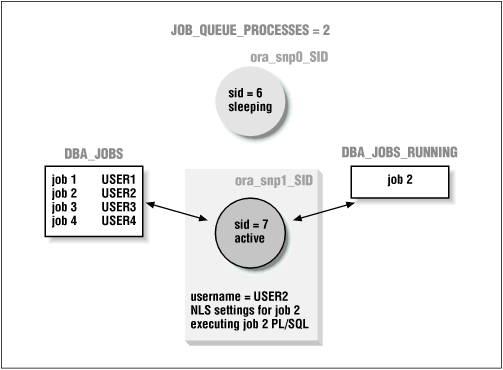Job Queue Architecture
The job queue is really a subsystem within an Oracle database, which uses dedicated background processes and catalog tables to execute user PL/SQL procedures automatically without user intervention. It is useful to get a good conceptual understanding of the job queue, because some of the behavior of this queue is not obvious. Figure Figure 13.1 shows a schematic of the job queue architecture.

Figure 13-1. Schematic of job queue architecture
INIT.ORA Parameters and Background Processes
These three INIT.ORA parameters are instrumental in controlling the job queue:
| JOB_QUEUE_PROCESSES |
| JOB_QUEUE_INTERVAL |
| JOB_QUEUE_KEEP_CONNECTIONS |
JOB_QUEUE_PROCESSES
The job queue (or SNP[18]) background processes are started when the Oracle instance is started. There are as many SNP processes started as specified in the INIT.ORA parameter JOB_QUEUE_PROCESSES. The range of valid values is from 0 to 36, so there can be a maximum of 36 SNP processes per Oracle instance. Under most operating systems, the characters SNP will appear as part of the process name. For example, under UNIX, an Oracle instance called DEV with three job queue processes would show the following process names:
| ora_DEV_snp0 |
| ora_DEV_snp1 |
| ora_DEV_snp2 |
One significant difference between the SNP background processes and other Oracle background processes is that killing an SNP process will not crash the instance. While you’re ...
Get Oracle Built-in Packages now with the O’Reilly learning platform.
O’Reilly members experience books, live events, courses curated by job role, and more from O’Reilly and nearly 200 top publishers.

